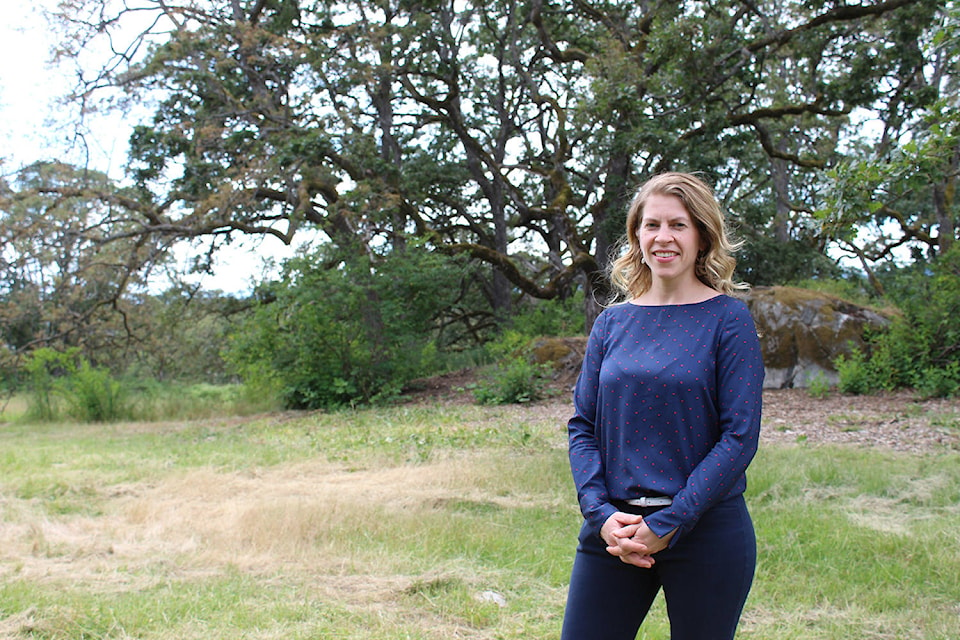A promient local academic has called on a Saanich councillor to support the proposed replacement of a controversial bylaw designed to protect environmentally sensitive areas.
In a letter to Coun. Rebecca Mersereau, Eric Higgs, professor of ecological restoration at the University of Victoria’s School of Environmental Studies, said “every effort matters” in asking her to support Natural Saanich, the proposed replacement of the Environmental Development Permit Area (EDPA) bylaw.
The author of numerous articles and books on the subject, Higgs has served as the school’s director and other scholars frequently cite his work.
Mersereau, who once campaigned on protecting the EDPA, said earlier this month that she would not support Natural Saanich, the proposed EDPA replacement, in a move that shocked many of her supporters, a fact Mersereau herself has acknowledged.
“I already know [last week’s council] meeting was a pivotal experience for me,” said Mersereau earlier this month. “I chose pragmatism over politics. I advocated for what I felt was the right approach and the most effective approach, rather than the most popular one, or the one based on a particular ideology. As a scientist turned policy-maker, that was always my intent with this new elected role.”
RELATED: Saanich councillor ‘chose pragmatism over politics’ in opposing EDPA replacement
Among other points, Mersereau said Saanich should focus its limited resources on protecting the eco-diversity of its own park system (rather than private properties), step up public education around biodiversity, and create financial incentives for private landowners to do their part.
Higgs said in his letter that he “admired” Mersereau’s “thoughtful” approach to this “complicated and contentious file” in agreeing with her comments significance of parks and education in any successful program. “I differ with you in one important respect,” he said. “[We] need the small, distributed pockets of biodiversity stretched across public and private lands.”
RELATED: Saanich councillor warns of ‘torturous experience’ as they consider replacing EDPA
Among other points, Higgs said isolated pockets of plants associated with Garry-oak ecosystems can be also found in private backyards in addition to public parks.
“These stepping stones, whether in degraded, intact, or cultivated pockets are vital in connecting plants but also obligate and generalist pollinators and the higher-level trophic species that depends on the intricate food webs,” said Higgs. “We do not always know the tipping points that cause species to flourish in such urban matrices, or what causes them to collapse. One things is for certain: every effort matters.”
Natural Saanich also promises to “stem the destruction of intact and degraded native habitat,” said Higgs in pointing to recent developments on Milner Avenue.
“We need regulatory capacity to limit negative actions, and reward virtuous ones,” he said. “This is why I support very strongly the kind of integrated package of initiatives comprising the Natural Saanich project. Stripping out the potential for discouraging or stopping heedless actions on private lands, or focusing only on remaining jewels that make up such a tiny fraction of historical habitat, will result in a future Saanich that is like every other municipality that failed to address issues sooner.”
Ultimately, Higgs calls on Mersereau to look at the bigger picture.
“Yes, environmental conditions are changing—a fact I know too well from my own research on novel ecosystems—but this is hardly an argument for letting the perfect stand in the way of good outcomes, especially those that support innovative approaches to biodiversity conservation and restoration,” he said. “Every remnant patch of biodiversity that can be conserved or restored, makes a difference to climate adaptation and flourishing ecosystems, whether natural, novel, or hybrid.”
Mersereau for her part did not directly address the concerns that Higgs raised.
“I’ve received correspondence from all kinds of people, with a whole range of opinions in the last couple of weeks,” said Mersereau. “I don’t have any comments or reactions to provide at time because I’m still receiving and reviewing information.”
Council will resume debate about Natural Saanich on July 8.
